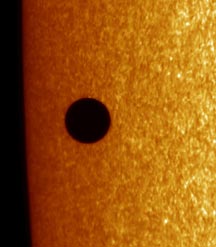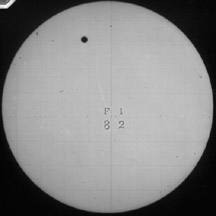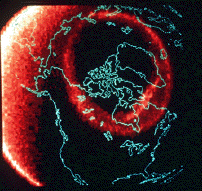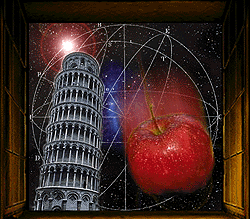The dark circle in this picture is the planet Mercury. Mercury is in front of the Sun. This picture was taken during a transit in 2003. The transit is almost over and Mercury is near the edge of the Sun.
Click on image for full size
Image courtesy of The Royal Swedish Academy of Sciences.
Transit
"Transit" is a special term astronomers use. A transit is like an eclipse
of the Sun. When an eclipse of the Sun happens, the Moon gets between us
and the Sun and blocks the sunlight. When a transit happens, a planet gets
between us and the Sun. The planet doesn't cover up the Sun like the Moon does,
though. Planets are very far away. The planet looks like a small black dot
on the Sun when a transit happens.
There are only two planets that can have transits. Only planets that are closer
to the Sun than Earth is can have transits. Can you guess which planets those
two are? The transit planets are Mercury and Venus!
Transits don't happen very often. There are about 13 or 14 transits
of Mercury every 100 years. Transits
of Venus are very rare. The last Venus transit was in 1882! There will be
another transit of Venus in June 2004.
You might also be interested in:

The planet Mercury crossed in front of the Sun on May 7, 2003. When that happens, astronomers call it a transit. A transit is like a solar eclipse. An eclipse happens when the Moon passes in front of the
...more
Sometimes the planet Venus gets between Earth and the Sun. When it does, we see a black dot move across the Sun. The black dot is Venus. Astronomers have a name for this. They call it a "transit"
...more
Sometimes planets go in between Earth and the Sun. When that happens astronomers call it a "transit". On June 8, 2004, the planet Venus will move between Earth and the Sun. There will be a transit of Venus!
...more
Sometimes the planet Venus goes between Earth and the Sun. From Earth it looks like a black dot moves across the Sun. Astronomers call this a transit of Venus. Transits of Venus don't happen very often.
...more
The planet Mercury will cross in front of the Sun on Wednesday, November 8, 2006. When that happens, astronomers call it a transit. A transit is like a solar eclipse. An eclipse happens when the Moon passes
...more
"Transit" is a special term astronomers use. A transit is like an eclipse of the Sun. When an eclipse of the Sun happens, the Moon gets between us and the Sun and blocks the sunlight. When a transit happens,
...more
From the ground the aurora can usually seen at night on Earth at the latitudes shown in this image. Those latitudes span Fairbanks, Alaska, Oslo, Norway, and the Northwest Territories.
...more
Gravity is one of the universal forces of nature. It is an attractive force between all things. The gravitational force between two objects depends on their masses, which is why we can really only see
...more











